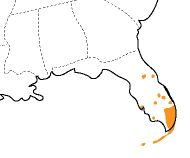Amerafrican House Gecko
Scientific Name: Hemidactylus mabouia / Common Names: Amerafrican House Gecko
|
By day, this gecko's tan to gray or olive color and darker, and backward pointing chevron markings across the back, are excellent camouflage. At night, the body lightens, sometimes to an almost ghostly appearance. The body, particularly the sides, is covered with warty tubercles. Unlike other Hemidactylus species, the toepads of the fourth toe in the Amerafrican House Gecko do not extend to base of digit. Adults are usually about 4 in. (11 cm) long, but may reach 5 in. (13 cm) TL.
Habitat and Range This species is known from southern Florida, from the keys and Everglades National Park north as far as Palm Beach on the east coast. There is an isolated population in Collier County along the west coast. It is rapidly expanding its range, and is also the species most likely to spread away from buildings and urban habitats into more rural, undeveloped ones. It was originally known from tropical and sub-tropical sub-Saharan Africa. Habits Amerafrican House Geckos can be voracious, taking hatchling anoles and tiny geckos as well as insects and invertebrates. They are a rather noisy species, squeaking when defending a territory or when grabbed. This species is a communal nester, each female producing several sets of two eggs each. Cuban Treefrogs (Osteopilus septentrionalis) and Tokay Geckos are known to prey on Amerafrican House Geckos. Similar Species The Amerafrican House Gecko and Mediterranean Gecko have enlarged tubercles on the back, however the Indo-Pacific Gecko may have small tubercles restricted to its dorsum or dorso-lateral rows, and the Common House Gecko has only small or no tubercles. In the Amerafrican House Gecko the toepads of the fourth toe do not extend to the base of the toe, whereas in the Mediterranean Gecko, these pads reach to the base of the toe. The Common House Gecko has rows of enlarged spines encircling the tail, whereas in the Indo-Pacific Gecko spines are only found scattered along the edges of the tail. Conservation & Other Threats The Amerafrican House Gecko is rapidly expanding its range in southern Florida. There are no native Florida scansorial geckos with which it might compete, but it seems to be displacing some other introduced species. Its possible affect as competitor or even predator on the native Florida Reef Gecko or other lizards is unknown. This species profile relies heavily on: Bartlett & Bartlett 1999; Lever 2003; McKeown 1996; Meshaka et al. 2004 |
Size:
Habitat:
Active During:
Diet:
Color/Pattern:
Location:
|










